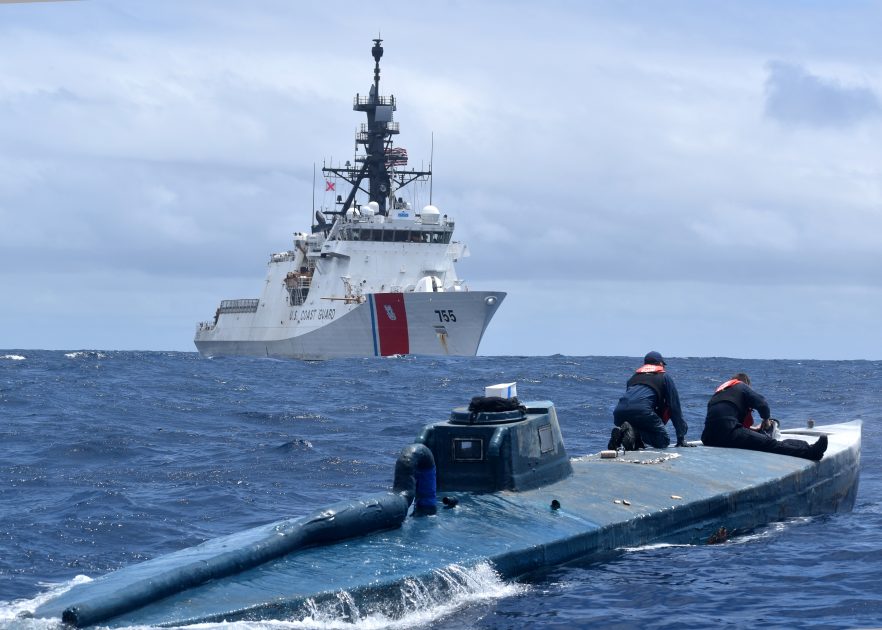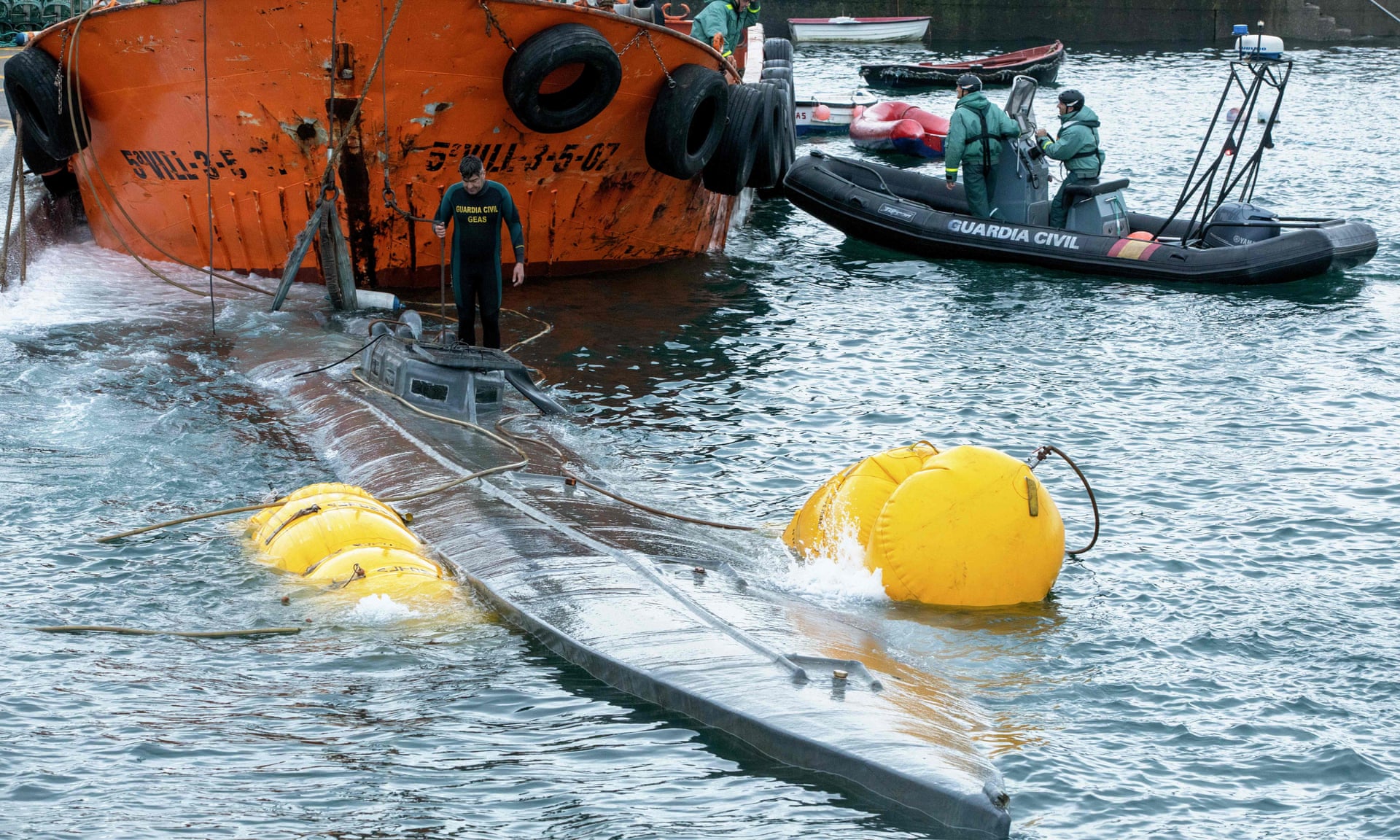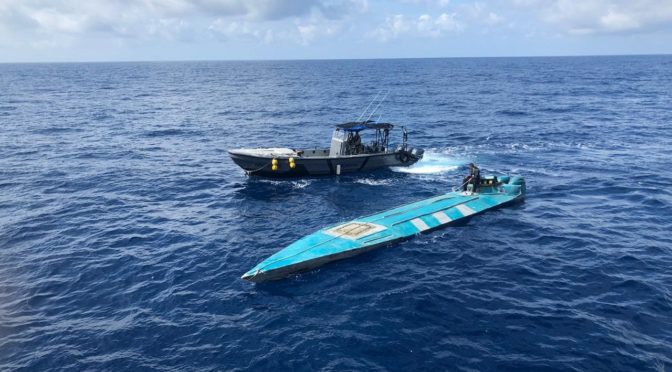By Collin Fox
In September 2018, the Panamanian Aeronaval Service (SENAN) captured a fairly crude low-profile vessel (LPV). It was their first of several; just a few months ago they tracked and captured a more sophisticated semisubmersible LPV carrying five tons of cocaine. Despite these occasional successes, most LPVs go undetected on their slow but profitable transits. They barely peek above the waves and practically disappear into a very big ocean, reminiscent of so many other covert craft. Drug trafficking organizations (DTOs) have evolved these covert vessels over decades in response to the steadily improving reconnaissance capabilities of a determined adversary. They have developed a type of vessel that is simple, affordable, attritable, low-observable, long-range, and can be built with relative ease in crude jungle shipyards. But what does losing the War on Drugs have to do with winning great power competition?
China has developed considerable surveillance and reconnaissance capabilities in its near seas, akin to what the United States has long enjoyed in the Caribbean and Eastern Pacific to detect and monitor illegal drug trafficking. The United States Navy now faces the oddly similar challenge of operating in a contested maritime environment against a powerful competitor armed with a robust reconnaissance-strike complex. The cartels could relate. The Navy’s Distributed Maritime Operations (DMO) concept for countering China in the Western Pacific hinges on Medium Unmanned Surface Vessels (MUSVs) to perform ISR and EW roles, but in order to be effective, these vessels must be as covert and ubiquitous as drug trafficking semisubmersibles. By taking a few notes from the narcos, the United States Navy can develop a class of hard-to-detect semisubmersible MUSV that will be combat-effective in the high-end fight.
How Will the MUSV Support the Fleet?
“The crux of successful command is to know when to commit available attack potential to attack effectively first. Modern naval battle will be fast, destructive, and decisive. More often than not the result will be decided before the first shot is fired.”
That incisive summary ends the chapter on modern tactics in the third edition of the essential Fleet Tactics and Naval Operations by the late CAPT Wayne P. Hughes, Jr. and RADM Robert P. Girrier (ret.). A persistent, connected, and widely distributed scouting force allows the commander to see the battlespace more clearly than the enemy, enabling that first effective attack that is so vital for winning a modern naval battle. Unfortunately, the Navy’s top-heavy fleet architecture lacks scouting ships that commanders can confidently deploy hundreds of miles inside a threat envelope. The carrier air wing lacks the range and persistence for this task, while both satellites and most shore-based ISR aircraft lack survivability in such a heavily contested battlespace.
This capability gap gives some context to the Navy’s budget justification for MUSVs, which outlines several elements:
-
-
MUSV will be a key enabler of the Navy’s Distributed Maritime Operations (DMO) concept, which includes being able to forward deploy (alone or in teams/swarms), team with individual manned combatants or augment battle groups. Fielding of MUSV will provide the Navy increased capability and necessary capacity at lower procurement and sustainment costs, reduced risk to sailors and increased readiness by offloading missions from manned combatants.
-
MUSV is defined as having a reconfigurable mission capability which is accomplished via modular payloads with an initial mission capability to support Battlespace Awareness through Intelligence, Surveillance and Reconnaissance (ISR) and Electronic Warfare (EW).
-
MUSVs will support the Navy’s ability to produce, deploy and disburse ISR/EW capabilities in sufficient quantities and provide/improve distributed situational awareness in maritime Areas of Responsibility (AORs). MUSVs will be designed to be attritable assets if used in a peer or near-peer conflict. MUSVs will initially be capable of semi-autonomous operation, with operators in-the-loop or on-the-loop.
-
MUSVs will be capable of weeks-long deployments and trans-oceanic transits, and operate aggregated with Carrier Strike Groups (CSGs) and Surface Action Groups (SAGs), as well as have the ability to deploy independently.
-
The Navy defines MUSVs as ranging from 12 to 50 meters (40 to 164 feet). This author has argued for a larger MUSV based on the Sentinel-class as a means of first developmentally maturing unmanned technology aboard an optionally manned vessel, before leveraging these “proven systems in a more capable, purpose-built platform.” A larger and optionally manned MUSV would also have more flexibility for weapons carriage and local release authority, but the more narrowly scoped ISR and EW missions envisioned for MUSVs in the budget justification suggest a stealthier and less expensive MUSV variant as well – something akin to the narco semisubmersibles, albeit with a very different payload.
Divergent Requirements Yield Diverse Designs
The Navy’s mission requirements for the MUSV pulls the design in two directions: toward vessels that are best suited for operations “aggregated with Carrier Strike Groups (CSGs) and Surface Action Groups (SAGs)” on the one hand, and those that “forward deploy (alone or in teams/swarms)” on the other. However, two purpose-built classes of MUSVs, rather than one, could more effectively and more efficiently satisfy these divergent requirements.
Despite the evident trend toward consolidating single-mission platforms into fewer types with ever-broader mission sets, as exemplified by the F/A-18, the Navy’s portfolio of support ships, boats, and watercraft remains stubbornly diverse. Why? Compared to aircraft, submarines, or surface combatants, these vessels have more stable and better-understood design requirements, lower system complexity, and rely on mature technology, while also having shorter lifecycles and lower lifecycle costs. The industrial base that makes these small vessels has more competitors, more civilian industry crossover, lower non-recoverable engineering expenses, and lower barriers to entry. These systemic factors continue to produce a diverse array of boats with tightly focused missions. Riverine, special warfare, force protection, patrol, and utility missions each get at least one purpose-built boat whose form follows its function, rather than all sharing an exquisitely expensive multi-mission design that is capable of doing nothing specific especially well.

The systemic factors that apply to manned small vessels also largely apply to the design and production of comparably sized unmanned vessels. Just as the Navy can afford its diverse portfolio of manned vessels to perform their equally diverse mission sets, it can likewise afford more than one MUSV design in order to better achieve divergent MUSV mission sets. A relatively larger MUSV should perform escort missions and a smaller semisubmersible MUSV should perform penetrating ISR and EW missions. The distinct required capabilities placed within different planned operational environments yields unique vessel designs, where form follows function.
An MUSV optimized for SAG and CSG operations would need to have both speed and range, which would dictate more powerful main propulsion, a relatively longer waterline for a higher efficient hull speed, and greater displacement for greater fuel stores. These factors would produce a vessel at least as large as the Sea Hunter, whose configuration (132’ LOA and 145-ton displacement) reflect its high-endurance, moderate-speed mission of tracking and trailing conventional submarines. These relatively larger and faster vessels would certainly expand the SAG’s situational awareness, but mainly as pickets or loyal wingmen in an expanded defense-in-depth scheme. All else being equal, a larger and faster vessel with higher freeboard would be easier for the enemy to detect. It would also be more expensive. DMO needs many offensively-focused scouts deep inside the contested environment, feeding the commander critical information, confusing the enemy with electronic warfare, and thereby facilitating decisive attacks. Larger MUSVs optimized for SAG and CSG operations would lack the stealth and attritable numbers to effectively fill this role.
Smaller and semisubmersible MUSVs, on the other hand, would have both stealth and numbers. Operating well beyond the air defense umbrella of a SAG or CSG, this class of MUSVs would need to be stealthier in order to avoid detection. Not having to keep up with the SAG or CSG, though, it could afford to be much slower. Such a slower and necessarily stealthy vessel could and indeed should be smaller, making it less expensive and therefore more readily affordable to buy in the abundant quantities needed to enable DMO.
Designing a Semisubmersible MUSV
Craft-built narco LPVs are survivable and effective simply because they are very difficult to find, even when the searcher employs dedicated maritime patrol aircraft within a permissive operating environment. This is especially true for semisubmersible LPVs. They can certainly be built for long range, as shown by the recent capture of a transatlantic semisubmersible LPV in Spain. Low-observable doesn’t necessarily mean expensive radar absorbent materials and or an exotic shape; a hand-laid fiberglass deck with minimal freeboard works, too.

The defense industry could make a truly low-observable MUSV warship as an evolution from the crude, jungle-built semisubmersibles produced by drug cartels. Much of a typical semisubmersible LPV’s roughly $1-2M construction costs are a function of being hand-built at small, clandestine shipyards. By designing for simplicity while leveraging industrial fabrication and economies of scale, the Navy could create a far better vessel than the cartels and for less money. These relatively inexpensive vessels would become truly attritable or even expendable in conflict. A commander could distribute scores to hundreds of these hard-to-detect ISR and EW platforms throughout the contested environment to develop battlespace awareness, while also overwhelming the enemy’s ability to detect them.
Those few semisubmersible MUSVs detected by an adversary would remain difficult and sortie-intensive to track and neutralize. The most sophisticated anti-ship cruise missiles would have a vanishingly low probability of kill (Pk) against a vessel with little more freeboard than a surfboard, while backscatter would challenge the accurate employment of laser-guided weapons. The target would demand precise and locally employed weapons. The enemy’s costs in sorties, weapons, manpower, and bandwidth for each laborious neutralization would be disproportionately higher than the costs of deploying that vessel. Neutralizing these detected vessels would have little impact on the fleet’s distributed ISR and EW capabilities, just as neutralizing drug-trafficking LPVs has done little if anything to change the price and availability of cocaine. This approach would impose significant costs on the enemy while affording significant advantages to the U.S. Navy.
A Common Objection Answered
The Navy’s budget justification addresses the concern that unmanned surface vessels would be more vulnerable to capture and exploitation than a manned vessel:
“MUSV C2, combat and/or weapon system integration will employ tamper proofing and security controls to prevent disclosure of data and electronic warfare defenses during autonomous operation. MUSVs will employ a Risk Management Framework (RMF) approach with physical, technical and administrative security controls. MUSVs will have hardware and software components to protect classified/sensitive functions, countermeasures designed to thwart adversary exploitation, classified data sanitation requirements, anti-tamper mechanisms to prevent disclosure of data and autonomous zeroization and electronic warfare defenses.”
These concerns and mitigations would apply to all classes of MUSVs, but as low freeboard vessels that are designed to operate nearly submerged, semisubmersible MUSVs would be that much easier to scuttle when unexpected guests step aboard. Cartels have used this tactic themselves to sink narco subs just prior to capture in a bid to destroy evidence and evade prosecution.
Conclusion
This proposed class of semisubmersible MUSVs is no panacea, but it represents one important step toward operationalizing the unmanned force structure needed for DMO. If the U.S. Navy hopes for more success in implementing DMO than it has achieved in the War on Drugs, it needs to humbly study the successes of adversaries and creatively adapt their most successful innovations. Creating a semisubmersible MUSV that is simple, affordable, attritable, low-observable, and long-range will do just that.
Lieutenant Commander Collin Fox, U.S. Navy, is a Foreign Area Officer serving as the Navy and Air Force Section Chief at the Office of Defense Cooperation, U.S. Embassy, Panama. He is a graduate of the Naval Postgraduate School and the Chilean Naval War College. The views presented are his alone and do not necessarily represent the views of Department of Defense or the Department of the Navy.
Featured Image: A low-profile vessel pictured in April 2019 (SENAN Panama)


Well written and timely piece – thanks LCDR Cox. As well as an opportunity for the US Navy, LSVs also continue to represent a threat because of their low-cost and effectiveness.